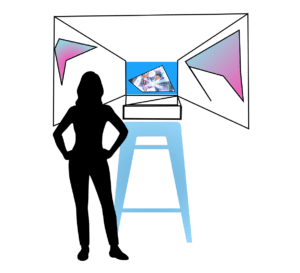My current focus is the exploration of digital art projects with the added element of interactivity, and how this additional aspect influences the art experience for the audience. I further explored the effect of seeing user’s own face reflected in the project, by exploring digital artists whom used Style Transfer mirrors. Wondering how a person would feel if they had some control over the sequence of events of them observing the art project, as well their reaction to seeing their own reflection – became my two focal points in the development of this project.
I am building a display (Fg. 1) that will be centred around a screen, with mirrors positioned to reflect the screen towards one another, a “control panel” in reach of the users’ hand, and potentially a headset (depending if audio elements will be incorporated).
Figure 1.

In the most simple terms: I want to create a(n audio-)visual experience that will activate the camera feature and showcase the users face in the finale of their experience of navigating through visual sketches. Human behavioural patterns tend to indicate a stronger sense of awareness of one-self when a reflection of their physical appearance is in sight. This particular phenomenon made me consider when are the times we lose touch with ourselves? A routine, a mundane rotation of the dynamic lifestyle can detach the individual from their true self. By provoking my audience to look at themselves, I am intending for them to capture a few moments out of their busy schedule to think about themselves, and what sort of emotion is triggered when you are just faced with yourself.
The more I dive into the ever-so developing aim of the project, the more I change the physical layout for the purpose of fulfilling the maxim extent of my vision. The display with a curtain, similar to a photo-booth opening and closing, would create a very intimate experience for the user, as there would be absolutely no distractions, just the visual aid of the screen and the mirrors, and themselves. I do truly believe the addition of audio aid would be beneficial, but I need to see the extent of my ability on this part and/or the ability to use other artists’ music. There will be no souvenir to keep from this experience, but rather a quick flashback of the emotion you felt when you saw your-self in a dark display in the IMA lab.
More technically: I will be creating visual animations with Processing, that will be at parts interactive with a joystick that the user will be able to play with. My plan right now is to create the visual experience, currently considering the time frame from 1-6 minutes; build a small prototype of the display checking the angles for the mirrors; having the first prototype fo the display in a week time.